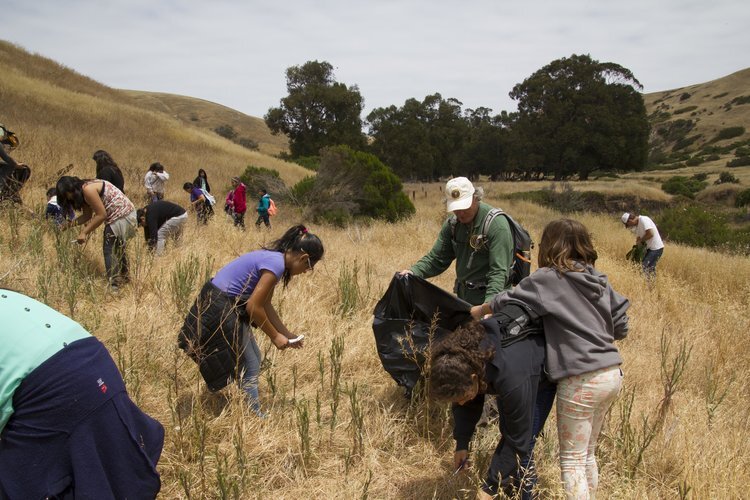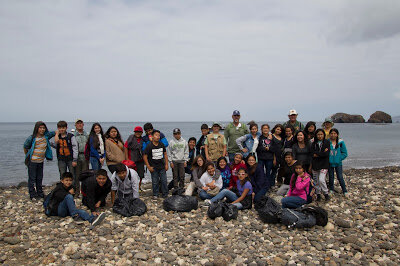

Santa Cruz Island
Santa Cruz Island
About Santa Cruz Island
At 96 square miles, Santa Cruz Island (Chumash: Limuw, meaning 'in the sea') is the largest of the eight Channel Islands. About one-quarter of this island is owned by Channel Islands National Park (the eastern end) and the rest is owned by the Nature Conservancy. The National Park side of the island offers the recreational opportunities, and the Nature Conservancy part is mostly closed to the public, with some exceptions. Boat owners can land on some of the Nature Conservancy property with a Conservancy permit, and the public is allowed to hike on the Pelican Trail (starting at Prisoners’ Harbor) with a guide from Island Packers.
An image of volunteers and Channel Islands Restoration staff on Santa Cruz Island in 2009
Overlooking Santa Cruz Island
At 96 miles, Santa Cruz is large covering a range of trails and geographic features.
Our Work On Santa Cruz Island
Channel Islands Restoration has been working on Santa Cruz Island since our inception in 2000. After proving our worth, we helped organize the Santa Cruz Island Native Plant Restoration Project in 2002.
Under this project, we successfully removed more than 30,000 invasive trees, worked directly to protect several species of endangered plants and brought hundreds of volunteers to the island to help in this critical work. CIR works/has worked with the following partners on these projects:
* The Nature Conservancy
* Southern California Wetlands Recovery Project
* U.S. Fish and Wildlife Service
* Santa Barbara County Weed Management Area
* UC Santa Barbara Santa Cruz Island Reserve
* U.S. Geological Survey
* Channel Islands National Park
* Santa Barbara Botanic Garden
East and West Santa Cruz Island
East Santa Cruz (NPS)
CIR works with Channel Islands National Park to remove non-native plants, collect seed and plant native species in sensitive habitats on the eastern end of Santa Cruz Island. We conduct both day-trips and multi-day trips to this portion of the island, and several hundred school kids and individuals have helped us with this project so far.
When you volunteer on Eastern Santa Cruz Island, you will be signed up as a National Park Service Volunteer. On single-day trips, participants perform service work at several important restoration sites, have the opportunity to hike on interesting trails and experience the National Park visitor center. On overnight trips, participants stay in the National Park Service campground and get involved with a wide variety of activities including evening educational activities (offered by CIR or the National Park Service), swimming, kayak excursions and hiking.
West Santa Cruz (The Nature Conservancy)
Channel Islands Restoration offers multi-day trips to perform critical habitat restoration and other volunteer work on western Santa Cruz Island on portions of the island owned by The Nature Conservancy. Participating groups have the opportunity to visit a gorgeous nature reserve reminiscent of California's past, while working to protect rare plant and animal species on the largest of the California Channel Islands. Contact CIR if your group would like to help us with this important work.
CIR personnel have been working on this portion of the island since 2000, and we helped organize the Santa Cruz Island Native Plant Restoration Project in 2002. Under this project, we successfully removed more than 30,000 invasive trees, worked directly to project several species of endangered plants and brought hundreds of volunteers to the island to help in this critical work. CIR is currently conducting a project to remove Vinca major from Cañada del Puerto, the largest riparian area on the island.
News Flash: About Our Educational School Trips To Santa Cruz Island!
You may think Santa Barbara Cleveland School’s mascot is the Dolphins, but for a couple of days in early May they became the Cleveland Clippers. That’s because each sixth grade class spent a day on Santa Cruz Island clipping the heads off of thousands of non-native oyster plants (Tragopogon porrifolius).
This invasive plant is native to Europe and known for its edible roots that taste like oysters.
However, in the U.S., like most invasive plants, the oyster plant has aggressively spread, smothering out native plants along the way, and has established itself as a roadside weed in nearly every state.
For most students, it was their first trip to the islands and their first boat ride ever. Dolphin, whale, and island fox sightings awed the students, as did the view at our Cavern Point picnic site. Eventually we found our way to the project site beyond the upper campground. There we spread out to locate non-native plants in various stages of bud, flower, and seed. Each student used safety scissors to clip off and carefully bag the heads. Most found the task to be pleasant, aside from dealing with the burrs of Ripgut grass, another invasive plant species, that nestled into their socks. After a couple of hours of hard work, we admired the huge pile of filled black plastic bags. Then, covered with white sap and burrs, we hauled them back to the mouth of Scorpion Canyon. We spent an hour or so to visit the Visitor’s Center and relax at the beach before the arrival of the return boat.
Kids remove invasive plants from Santa Cruz Island
The trips were a culmination of work by CIR board member Cindy Kimmick with sixth graders and their teachers, Sam Adams and Kevin Sullivan. Since Fall, Cindy, with the help of other CIR board members, provided the students with natural science lessons in topics including GPS mapping and the near decimation of the island foxes and made the learning process interesting for the students.
CIR was able to offer the trip free of charge using grants from the Men’s Garden Club of Santa Barbara, the Bentson Foundation, and Susan Shields. The funding covered the cost of the boat and the bus, plus the cost of our staff to organize and lead the trips.
A total of 55 students attended the trips, and five volunteer Work Leaders, in partnership with the Channel Islands National Park Service, also assisted the CIR staff with the trip, including Ron Nichols, Randy Bowin and Dennis Kulzer, plus CIR Board members Cindy Kimmick and Karen Telleen-Lawton.
School kids on their way to Santa Cruz Island to volunteer.
A group photo of the Cleveland School’s trip to Santa Cruz
Cleveland School was chosen because it is an underserved school with enthusiastic and environmentally-aware sixth grade teachers that is also the focus of outreach projects for one board member’s parish, All Saints-by-the-Sea Episcopal Church.
The highlight for many was the knowledge that thousands of bagged seeds will prevent millions of new plants: an invasion literally nipped in the bud. But likely most would name an additional favorite: watching hundreds of dolphins approach the boat and surf our wake. It was an enthralling show seemingly just for the graduating Cleveland Dolphins.
CIR thanks the Cleveland School, their teachers, Kevin Sullivan and Sam Adams, and their wonderful students for helping with this important restoration project on Santa Cruz Island!






